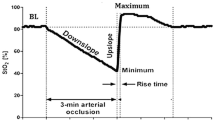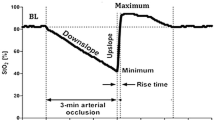Abstract
We compared the percentage haemoglobin oxygenation indices from two near infrared spectrophotometers (NIRS) to determine whether the devices reported similar changes in response to induced changes in oxygenation. Methods.24 healthy juvenile swine undergoing cardiac bypass surgery had INVOS 5100 and NIRO-300 sensors applied to the brow. Induced events included circulatory arrest, altered blood flow rate, core cooling, and re-warming. Results.The average data collection was 4 hours 36 minutes and had an r = 0.82 mean correlation between the INVOS and NIRO. The total resting baseline collection from all trials (8,590 pairs) had a correlation of r= 0.62. The average relationship between the INVOS and NIRO was non-linear: an INVOS regional oxygen saturation index (rSO2) of 0% was equivalent to a NIRO tissue oxygenation index (TOI) of 36.2%; values were equal at 56.8%; and an (rSO2) of 100% was equivalent to a TOI 85.9%. There was good or excellent agreement (r> 0.5) between the (rSO2) and TOI patterns of change during induced events in 96% of trials. The INVOS and N IRO were most closely correlated when an attenuation filter was used to obtain identical emitter/detector separations. Conclusions.There was close agreement between the INVOS 5100 and NIRO-300 in response to major physiological change, although absolute values of (rSO2) and TOI were not identical. There was less agreement during baseline measurements or minimal physiologic change.
Similar content being viewed by others
REFERENCES
du Plessis AJ, Newburger J, Jonas RA, Hickey P, Naruse H, Tsuji M, Walsh A, Walter G, Wypij D, Volpe JJ. Cerebral oxygen supply and utilization during infant cardiac surgery. Ann Neurol 1995; 37 (4): 488-497
LeBlanc JG, Blackstock D, Macnab AJ, Gagnon FA, Gagnon RE, Russell J, Ring T. Effects of propofol on cerebral oxygenation during cardiopulmonary bypass in children. Can J Anaesth 2000; 47 (11): 1082-1089
Nollert G, Jonas RA, Reichart B. Optimizing cerebral oxygenation during cardiac surgery: A review of experimental and clinical investigations with near infrared spectrophotometry. Thorac Cardiovasc Surg 2000; 48 (4): 247-253
Tamura M. Non-invasive monitoring of brain oxygen metabolism during cardiopulmonary bypass by near infrared spectrophotometry. Jpn Circ J 1991; 55: 330-335
Gagnon RE, Leung A, Macnab AJ. Variations in regional cerebral blood volume in neonates associated with nursery care events. AmJ Perinatol 1999; 16 (1): 7-11
Torella F, Cowley R, Thrniley MS, McCollum CN. Monitoring blood loss with near infrared spectroscopy. Camp Biochem Physiol A Mol Integr Physiol 2002; 132 (1): 199-203
Samra SK, Dy EA, Welch K, Dorje P, Zelenock GB, Stanley JC. Evaluation of a cerebral oximeter as a monitor of cerebral ischemia during carotid endarterectomy. Anesthesiology 2000; 93 (4): 964-970
Denet G, Talip A, Nevzat U, Serhat O, Gazi O. The evaluation of cerebral oxygenation by oximetry in patients with ischaemic stroke. J Postgrad Med 2000; 46 (2): 70-74
Sokol DK, Markand ON, Daly EC, Luerssen TG, Malkoff MD. Near infrared spectroscopy (NIRS) distinguishes seizure types. Seizure 2000; 9 (5): 323-327
Macnab AJ, Gagnon RE, Gagnon FA. Near infrared spectroscopy for intraoperative monitoring of the spinal cord. Spine 2002; 27 (1): 17-20
Muelner T, Nikolic A, Schramm W, Vecsel V. New instrument that uses near-infrared spectroscopy for the monitoring of human muscle oxygenation. J Trauma 1999; 46 (6): 1082-1084
Singer I, Dawn B, Edmonds H, Stickland TJ. Syncope is predicted by neuromonitoring in patients with ICDs. Pacing Clin Electrophysiol 1999; 22 (1 pt 2): 216-22
OIsen KS, Svendsen LB, Larsen FS. Validation of transcranial near-infrared spectroscopy for evaluation of cerebral blood flow autoregulation. J Neurosurg Anesth 1996; 8 (4): 280-285
Bartocci M, Winberg J, Papendieck G, Mustica T, Serra G, Lagercrantz H. Cerebral hemodynamic response to unpleasant odors in the preterm newborn measured by near infrared spectroscopy. Pediatr Res 2001; 50 (3): 324-330
Abdul-Khaliq H, Troitzsch D, Schubert S, Wehsack A, Bottcher W, Gutsch E, Hubler M, Hetzer R, Lange PE. Cerebral oxygen monitoring during neonatal cardiopulmonary bypass and deep hypothermic circulatory arrest. Thorac Cardiovasc Surg 2002; 50 (2): 77-81
Quaresima V, Sacco S, Totaro R, Ferrari M. Noninvasive measurement of cerebral haemoglobin oxygen saturation using two near infrared spectroscopy approaches. J Biomed Opt 2000; 5 (2): 201-205
Gagnon RE, Gagnon FA, Macnab AJ. Comparison of 13 published cytochrome c oxidase near-infrared spectroscopy algorithms. Eur J Appl Physiol Occup Physiol 1996; 74 (6): 487-495
Macnab AJ, Gagnon RE. Potential sources of discrepancies between living tissue near infrared spectroscopy algorithms. Anal Biochem 1996; 236 (2): 375-377
Gagnon RE, Macnab AJ. CIC++ Coding for matrix pseudo inverses in clinical near infrared spectroscopy. Comput Methods Biomech Biomed Engin 1998; 1 (2): 69-86
Kirkpatrick PJ. Use of near-infrared spectroscopy in the adult. Philos Trans R Soc Lond B Biol Sci 1997; 352 (1354): 701-705
Yoshitani K, Kawaguchi M, Tatsumi K, Kitaguchi K, Furuya H. A comparison of the INVOS 4100 and the NIRO 300 near-infrared spectrophoptometers. Anesth Analg 2002; 194 (3): 586-590
Cho H, Nemoto EM, Sanders M, Fernandez K, Yonas H. Comparison of two commercially available near-infrared spectroscopy instruments for cerebral oximetry. J Neurosurg 2000; 93 (2): 351-354
Grubhofer G, Tonninger W, Keznickl P, Skyllouriotis P, Ehrlich M, Hiesmayr M, Lassnigg A. A comparison of the monitors INVOS 3100 and NIRO 500 in detecting changes in cerebral oxygenation. Acta Anaesthesiol Scand 1999; 43 (4): 470-475
Gomersall CD, Leung PI, Gin T, Yoynt GM, Young RJ, Poon WS, Oh TE. A comparison of the Hamamatsu NlRO 500 and the INVOS 3100 near-infrared spectrophotometers. Anaesth Intensive Care 1998; 26 (5): 548-557
Author information
Authors and Affiliations
Rights and permissions
About this article
Cite this article
Gagnon, R.E., Macnab, A.J., Gagnon, F.A. et al. Comparison of Two Spatially Resolved NIRS Oxygenation Indices. J Clin Monit Comput 17, 385–391 (2002). https://doi.org/10.1023/A:1026274124837
Issue Date:
DOI: https://doi.org/10.1023/A:1026274124837




